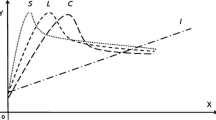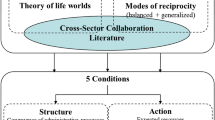Abstract
Cross-sector social partnerships (CSSPs) can produce benefits at individual, organizational, sectoral and societal levels. In this article, we argue that the distribution of benefits depends in part on the cognitive frames held by partnership participants. Based on Selsky and Parker’s (J Manage 31(6):849–873, 2005) review of CSSPs, we identify three analytic “platforms” for social partnerships – the resource-dependence platform, the social-issue platform, and the societal-sector platform. We situate platforms as prospective sensemaking devices that help project managers make sense of partnerships by calling attention to certain desired features or downplaying other features. We describe the three platforms and contrast them on factors that influence social benefit, including orientation, learning, and power. We provide illustrations of each platform and demonstrate how the choice of platform is consequential for practice, such as how a partnership project gets started, evolves and produces social benefits.
Similar content being viewed by others
References
Alter, K. & J. Hage. 1993. Organizations working together. Thousand Oaks: Sage.
Astley, G. & Fombrun, C. 1983. Collective strategy: Social ecology of organizational environments. Academy of Management Review, 8: 576-587.
Austin, J. 2000. The collaborative challenge. San Francisco: Jossey-Bass.
Bielak, D., S. M. J. Bonini and D. Oppenheim: 2007, ‘CEOs on Strategy and Social Issues’. The McKinsey Quarterly, Oct.
Bolman, L. and T. Deal: 2008, Reframing Organizations, 4th Edition (Jossey-Bass, San Francisco).
Boyd, B., N. Henning, E. Reyna, D. E. Wang and M. D. Welch: 2009, Hybrid Organizations: New Business Models for Environmental Leadership (Greenleaf, Chagrin Falls).
Bryson, J., B. Crosby and M. Stone: 2006, ‘The Design and Implementation of Cross-Sector Collaborations: Propositions from the Literature’. Public Administration Review, December(Special Issue), 44–55.
Christensen, C., H. Baumann, R. Ruggles and T. Sadtler: 2006, ‘Disruptive Innovation for Social Change’. Harvard Business Review December, 94–101.
Connected. Community Voice Mail Fact Sheet. Undated [approximately 2000].
Cropper, S., Ebers, M., Huxham, C. & Ring, P.S. (eds.) 2008. The Oxford handbook of inter-organizational relations. Oxford University Press.
Dass, P. & Parker, B. 1999. Strategies for managing human resource diversity: from resistance to learning. Academy of Management Executive, 13(2): 68–80.
Dutton, J. & Dukerich, J. 1991. Keeping an eye on the mirror: Image and identity in organizational adaptation. Academy of Management Journal, 34(3): 517-554.
Farrington, J. & Bebbington, A. with Wellard, K. & Lewis, D. J. 1993. Reluctant partners?: Non - governmental organizations, the state and sustainable agricultural development . London & New York: Routledge.
Faulkner, D. & de Rond, M. 2000. Perspectives on cooperative strategy. In Faulkner, D. & de Rond, M. (Eds.), Cooperative strategy: Economic, business and organizational issues: 3-39. Oxford University Press.
Feldman, M., A. Khademian, H. Ingram and A. Schneider: 2006, ‘Ways of Knowing and Inclusive Management Practices’. Public Administration Review December (Special Issue), 89–99.
Fitch, G. 1976. Achieving corporate social responsibility. Academy of Management Review, 1(1): 38-46.
Freeman, E. 1984. Strategic management: A stakeholder approach. Boston: Pitman.
Frooman, J. 1999. Stakeholder influence strategies. Academy of Management Review, 24(2): 191-205.
Gioia, D. & Mehra, A. 1996. Review of Karl Weick’s Sensemaking in organizations. Academy of Management Review, 21(4): 1226-1230.
Gioia, D. A., K. G. Corley and T. Fabbri: 2002, `Revising the Past (While Thinking in the Future Perfect Tense)', Journal of Organizational Change Management 15(6), 622–634
Googins, B. & Rochlin, S. 2000. Creating the partnership society: Understanding the rhetoric and reality of cross-sectoral partnerships. Business and Society Review, 105(1): 127-144.
Gray, B. 1989. Collaborating. San Francisco: Jossey-Bass.
Gray, B. & Wood, D. 1991. Collaborative alliances: Moving from practice to theory. Journal of Applied Behavioral Science, 27(1): 3-22.
Greening, D.W., & Gray, B. 1994. Testing a model of organizational response to social and political issues. Academy of Management Journal, 37(3): 467-498.
Hirschhorn, L and T. Gilmore: 2004, ‘Ideas in Philanthropic Field Building’, Practice Matters Series, Publication No.6. The Foundation Center.
Huxham, C. & Vangen, S. 1996. Working together: Key themes in the management of relationships between public and nonprofit organizations. International Journal of Public Sector Management, 9(7): 5-17.
Klitgaard, R and G. F. Treverton: 2003, ‘Assessing Partnerships: New Forms Of Collaboration’ New Ways to Manage Series. IBM Endowment for the Business of Government, Washington, DC.
Leach, W.D., Pelky, N.W., & Sabatier, P.A. 2002. Stakeholder partnerships as collaborative policymaking: Evaluation criteria applied to watershed management in California and Washington. Journal of Policy Analysis and Management, 21(4): 645-670.
Levy, R. & Oviatt, F., Jr. 1989. Corporate philanthropy. In Bill Cantor (Ed.), Experts in action: Inside public relations: 126-38. New York: Longman.
Levy, D. & Scully, M. 2007. The institutional entrepreneur as modern prince: The strategic face of power in contested fields. Organization Studies, 28(7): 971-991.
Linder, S.H. & Rosenau, P.V. 2000. Mapping the Terrain of the Public-private Policy Partnership. In Rosenau, P.V. (Ed.), Public-private policy partnerships: 1-18. Cambridge: MIT Press.
Lotia, N. and C. Hardy: 2008, ‘Critical perspectives on collaboration’. in S. Cropper, M. Ebers, C. Huxham and P.S. Ring (eds.), The Oxford Handbook of Inter-Organizational Relations (Oxford University Press, Oxford), pp. 366–389.
Maitlis, S. & T. Lawrence. 2003. Orchestral manoeuvres in the dark: Understanding failure in organizational strategizing. Journal of Management Studies, 40: 109-139.
McCann, J. 1983. Design guidelines for social problem solving interventions. Journal of Applied Behavioral Science, 19(2): 177-192.
McGann, J. & Johnstone, M. 2006. The power shift and the NGO credibility crisis. The International Journal of Not-for-Profit Law, 8(2): 65-77.
Nambisan, S. 2009. Platforms for collaboration. Stanford Social Innovation Review, 7(3): 44-49.
O’Riain. S. 2000. States and markets in an era of globalization. Annual Review of Sociology, 26: 187-213.
Oliver, C. 1991. Strategic responses to institutional processes. Academy of Management Review, 16: 145-179.
Parker, B. & Selsky, J. 2004. Interface dynamics in cause based partnerships: an exploration of emergent culture. Nonprofit and Voluntary Sector Quarterly, 33(3): 458-488.
Porter, M. and M. Kramer: 2006, `Strategy & Society: The Link Between Competitive Advantage and Corporate Social Responsibility', Harvard Business Review 84(12), 78–92
Porter, M. and M. Kramer: 2011, `Creating Shared Value: How to Reinvent Capitalism—and Unleash a Wave of Innovation and Growth', Harvard Business Review 89(1/2), 62–77
Prahalad, C.K. 2006. The fortune at the bottom of the pyramid. Upper Saddle River, NJ: Wharton School Publishing.
Purvis, R., V. Sambamurthy & R. Zmud. 2001. The assimilation of knowledge platforms in organizations: An empirical investigation. Organization Science, 12(2): 117-135.
Ring, P. & Van de Ven, A. 1994. Developmental processes of cooperative interorganizational relationships. Academy of Management Review, 19(1): 90-118.
Rondinelli, D.S. & Berry, M.A. 2000. Environmental citizenship in multinational corporations: Social responsibility and sustainable development. European Management Journal , 18(1): 70-84.
Salamon, L. 1987. Of market failure, voluntary failure, and third-party government: Toward a theory of government-nonprofit relations in the modern welfare state. Journal of Voluntary Action Research, 16(1/2): 29-49.
Salamon L. (2003) The resilient sector: The state of nonprofit America. Brookings Institution Press.
Schon, D: 1971, Beyond the Stable State (Norton, New York).
Seitanidi, M.M. & Crane, A. 2009. Implementing CSR through partnerships: Understanding the selection, design and institutinalisation of nonprofit-business partnerships. Journal of Business Ethics, 85: 413-429.
Selsky, J. & B. Parker. 2005. Cross-sector partnerships to address social issues: challenges to theory and practice. Journal of Management, 31(6): 849-873.
Simai, M.: 1994, The Future of Global Governance: Managing Risk and Change in the International System (U.S. Institute of Peace Press, Washington)
Smith, O.: 2004, ‘Excerpts from CI and Starbucks Bring Conservation Message to Seattle’, Oct. 28. Retrieved 8 Jan 2006 from http://www.celb.org/xp/CELB/news-events/events/starbucksseattledinner.xml.
Steins, N. & V. Edwards. 1999. Platforms for collective action in multiple-use common-pool resources. Agriculture and Human Values, 16,: 241-255.
Thompson, A., A. Strickland and J. Gamble: 2007, Crafting and Executing Strategy: The Quest for Competitive Advantage, 15th Edition (McGraw Hill, Irwin).
Tomlinson, F.: 2005, ‘Idealistic and Pragmatic Versions of the Discourse of Partnership’, Organization Studies 26(8), 1169–1188.
Trist, E.L. 1983. Referent organizations and the development of interorganizational domains. Human Relations, 36: 247-268.
USAID: 2004, ‘United States Agency for International Development Teams with Conservation International and Starbucks to Support Coffee Farmers and Promote Environmentally Friendly Coffee Cultivation’, Sept 27. Retrieved 8 Jan 2006 from http://www.csrwire.com.
Van de Ven, A.: 1976, `On the Nature, Formation, and Maintenance of Relations Among Organizations', Academy of Management Review 1(4), 24–36
Waddell, S. 2000. New institutions for the practice of corporate citizenship: Historical, intersectoral, and developmental perspectives. Business and Society Review, 105(1): 107-126.
Waddock, S. 1991. A typology of social partnership organizations. Administration & Society, 22(4): 480-516.
Waddock, S. 2008. Building a new institutional infrastructure for corporate responsibility. Academy of Management Perspectives, 22(3): 87-108.
Waddock, S.A. & Smith, N. 2000. Relationships: The real challenge of corporate global citizenship. Business & Society Review, 105(1): 47-62.
Walsh, J., Weber, K. & Margolis, J. 2003. Social issues in management: Our lost cause found. Journal of Management, 29(6): 859-881.
Weisbrod, B.A. 1997. The future of the nonprofit sector: Its entwining with private enterprise and government. Journal of Policy Analysis and Management, 16(4): 541-555.
Westley, F. and H. Vredenburg: 1991, `Strategic Bridging: The Collaboration Between Environmentalists and Business in the Marketing of Green Products', Journal of Applied Behavioral Science 27(1), 65–90
Wright, A. 2005. The role of scenarios as prospective sensemaking devices. Management Decision, 43(1): 86-101.
Wymer, W.W. & Samu, S. 2003. Dimensions of business and nonprofit collaborative relationships. Journal of Nonprofit and Public Sector Marketing, 11(1): 3-22.
Young, D.R. 1999. Nonprofit management studies in the United States: Current developments and future prospects. Journal of Public Affairs Education, 5(1): 13-23.
Young, D.R. 2000. Alternative models of government-nonprofit sector relations: Theoretical and international perspectives. Nonprofit and Voluntary Sector Quarterly, 29(1): 149-172.
Author information
Authors and Affiliations
Corresponding author
Rights and permissions
About this article
Cite this article
Selsky, J.W., Parker, B. Platforms for Cross-Sector Social Partnerships: Prospective Sensemaking Devices for Social Benefit. J Bus Ethics 94 (Suppl 1), 21–37 (2010). https://doi.org/10.1007/s10551-011-0776-2
Published:
Issue Date:
DOI: https://doi.org/10.1007/s10551-011-0776-2




